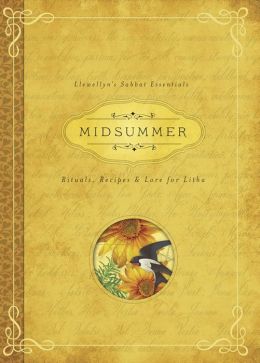I can't say enough good things about this series from Llewellyn. The authors chosen have done a fantastic job of putting together books that would be welcome additions to the libraries of new practitioners and seasoned pros alike.
As with Beltane, Midsummer starts off with a series introduction, laying out the way that they've organized each book in the series. Interestingly, it differentiates between the Wheel of the Year in the northern hemisphere and the Wheel of the Year in the southern hemisphere. It moves into Old Ways, outlining a myriad of ways that people have celebrated the Sabbat in the past. It then talks about New Ways and the more modern approaches to celebrating.
In the Spells and Divination section, there is a set of elemental spells: Healing Water Magick (Water), Greet the Dawn (Air), Fire Power Candle Magick (Fire), Green and Growing Herbal Prosperity (Earth). Those are followed by Thor's Summer Storm Spell and a Crystal Spell for Courage, Protection, and Strength. There is then a section on folk divination, followed by more modern approaches to divination. The section ends with a small listing of herbal spells and charms, which includes a bit of history and lore about the chosen Midsummer herbs, as well as a specific way to use each of them.
The Recipes and Crafts section has, as one may expect, light recipes suitable for an outdoor picnic-type ritual or gathering. There are a few green and grain salads, salsa, bread, fruit salads, leg of lamb, a couple of desserts, and a fruited wine recipe. The craft section has sunshine wreaths of herbs and flowers, Viking boats, cinnamon brooms, bird feeders, herbal sachets, wands, and divining rods. The section finishes up with a few decorating ideas for the season.
The final two sections are Prayers and Invocations and Rituals of Celebration. They include meditations, affirmation, invocations to multiple deities in multiple pantheons, quarter calls, prayers for specific things, a solitary ritual to Draw Down the Sun, a healing and abundance group ritual, and a small group ritual to invoke the faeries that is suitable for children. My only issue with that last one is that it presumes that all fairies are small fluttery creatures and doesn't touch on the darker side of the fae. As it's specifically called out for children, though, I can understand it. It's a solid framework that can be adapted to a light/dark duality if desired by group facilitators. The book ends with a correspondences appendix.
I know I sound like I'm gushing about these books, and maybe I am, but I'm really impressed with the thought and work that's gone into them. They're solid books, and while they may not be all things for all people, they're going to be a great set to add to any library.
~review by Jeremy Bredeson
Author: Deborah Blake
Llewellyn Books, 2015
220 pages
Midsummer: Rituals, Recipes & Lore for Litha

©
2010 - 2025
Facing North
